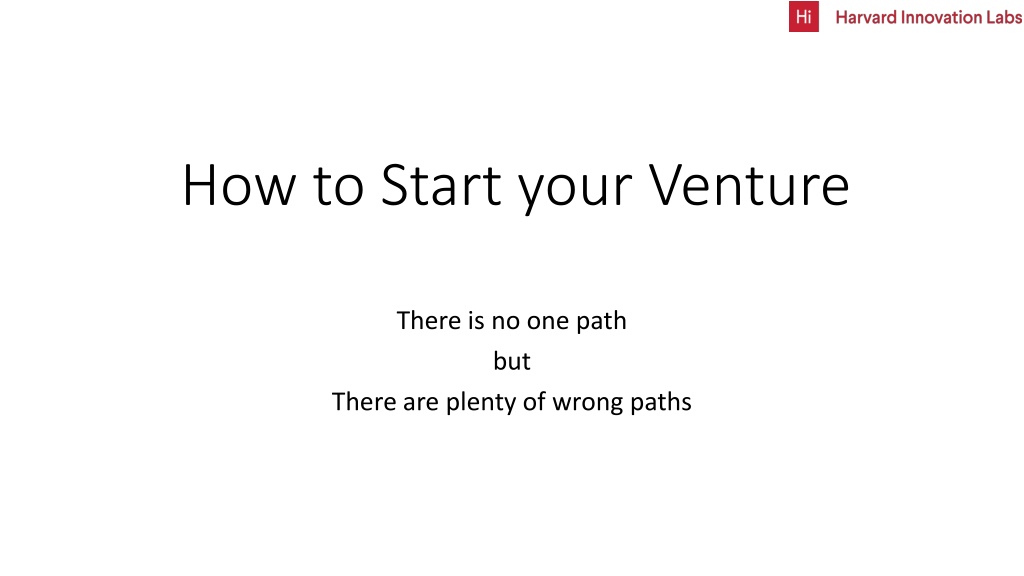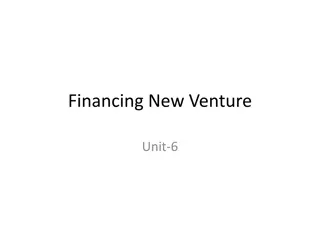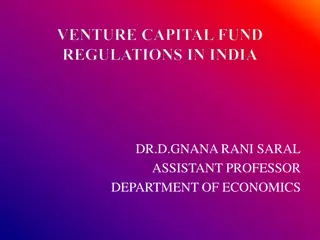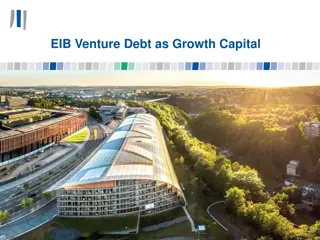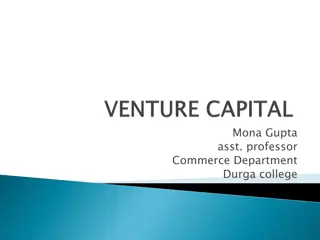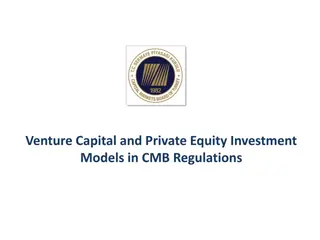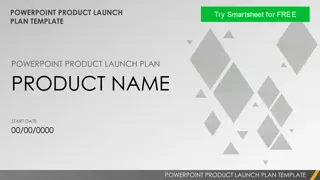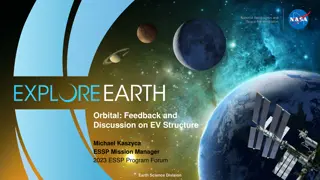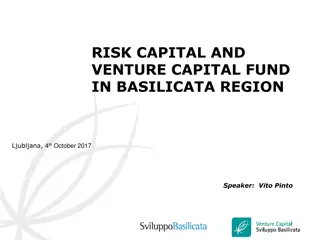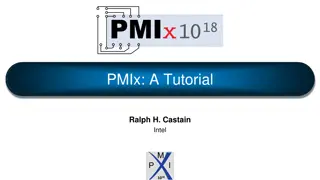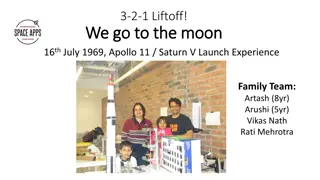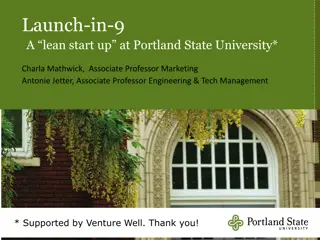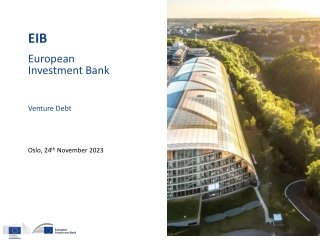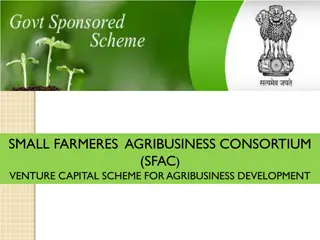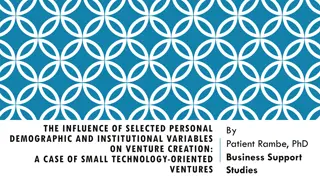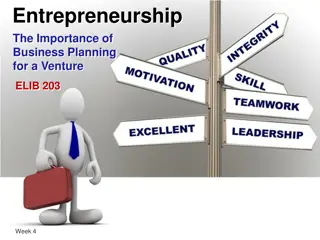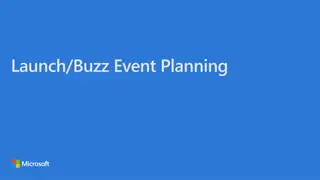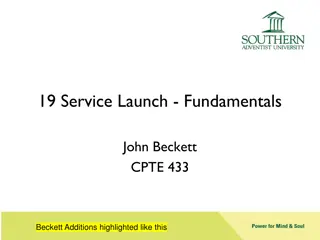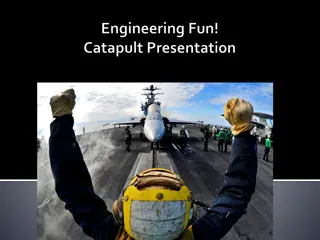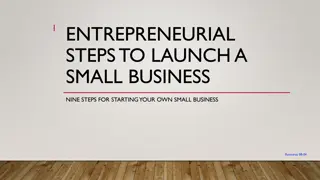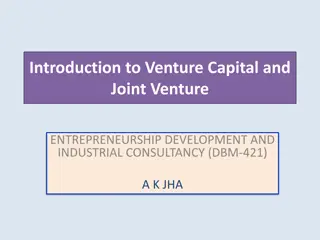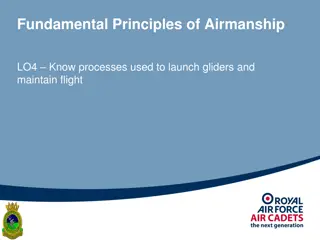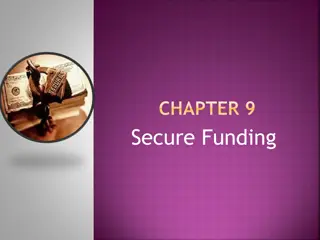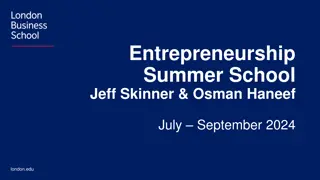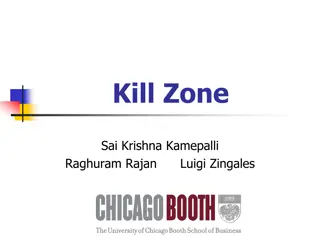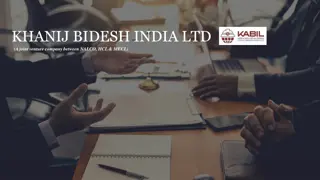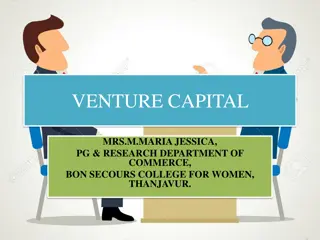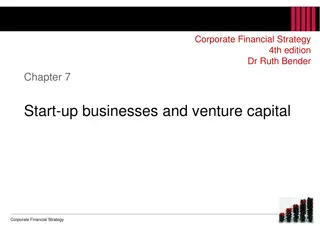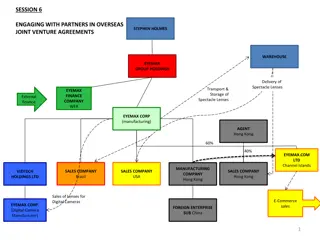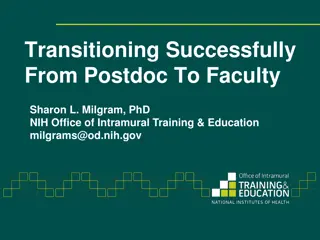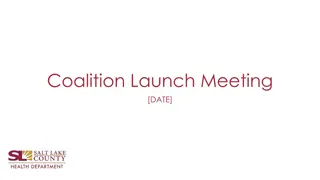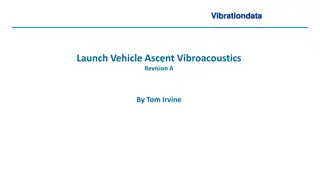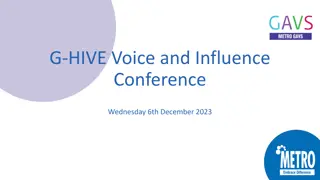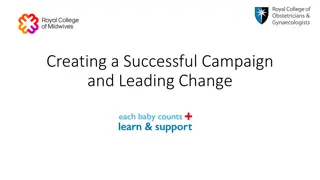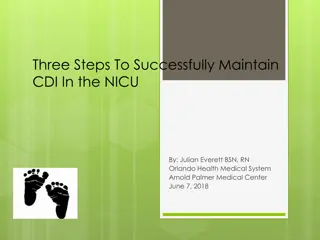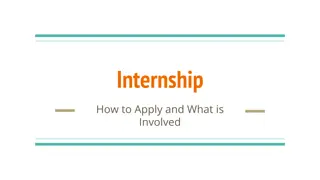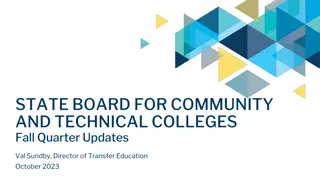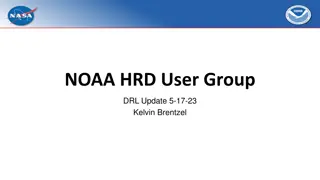Essential Steps to Launch Your Venture Successfully
Explore the key steps to kickstart your venture effectively, from refining your idea and conducting customer discovery to identifying target customers and building a minimum viable product. Embrace the entrepreneurial mindset and learn how to avoid common pitfalls along the way.
Uploaded on Sep 30, 2024 | 0 Views
Download Presentation

Please find below an Image/Link to download the presentation.
The content on the website is provided AS IS for your information and personal use only. It may not be sold, licensed, or shared on other websites without obtaining consent from the author. Download presentation by click this link. If you encounter any issues during the download, it is possible that the publisher has removed the file from their server.
E N D
Presentation Transcript
How to Start your Venture There is no one path but There are plenty of wrong paths
Welcome We will be recording the workshop Please turn your cameras on Ask questions in the chat Please give us feedback: https://www.surveymonkey.com/r/Spri ng24B2BWorkshop
Want to start a Want to start a venture but aren t venture but aren t quite sure where to begin? quite sure where to begin? 6 Steps to increase your chances of success
The Entrepreneur's Mindset Thinking to avoid My tech is cool My friends want this so everyone will want it I need to build something now I need to speak to a VC now Thinking to cultivate Customers understand their problems better than you do Customer are motivated by their priorities not yours Customers have lots of choices Customers care about solving their problems not about how cool your tech is
Six Steps to Start Your Venture 1. Refining your idea If you have an idea: 2. Customer Discovery 3. Interviewing basics 4. Iterate on your idea 5. Identify your early target customers 6. Build an MVP to test your offering
Six Steps to Start Your Venture 1. Define who you want to serve If you don't have an idea (it might be a lot better): 2. Customer Discovery 3. Interviewing basics Let go of your idea (ego) and find success. 4. Iterate on your idea 5. Identify your early target customers 6. Build an MVP to test your offering
Step 1: Refine your idea Who is the customer? Is your user different from the person that pays? What problem are they looking to solve? What is your proposed solution? How do you provide value? This is the first iteration of your idea, you will revisit it after talking to customers
Step 2: Customer discovery What you want to know about the customer Does the customer have a problem? Do they know they have a problem? Are they actively trying to solve the problem or are they using something to solve it, but they don t like it? Do they have budget to spend on a solution? Don t just validate the problem validate your solution
Remember #1 reason startups fail is lack of customer demand
Step 3: Interview customers Follow the advice from the Mom Test: Don't ask leading questions. Ask open ended questions, and follow up. Use the 5 Whys to get to root cause.
Questions to Ask in Customer Interviews Could you talk me through last time that happened? What are the implications if you fail to solve the problem? What else have you tried? What s wrong with what you ve tried already? How much are you currently spending to solve the problem? Is there anything else I should have asked? Finally, Who else should I talk to? StudioZao on Customer Discovery Questions
Best Question to Ask if you don t have an idea What problem would you pay me to solve?
Question to Avoid in Customer Interviews Do you think it s a good idea? Would you buy this product? How much would you pay for it? Would you pay $x for a product that did this? Avoid hypothetical questions about the future, most people are overly optimistic. Instead, ask about past behaviors.
Step 4: Iterate Take the learnings from your customer interviews and go back to Step 1 and refine your Idea. Who is the customer? Did you get that right? What problem are they looking to solve? Is this an urgent problem for them? What is your proposed solution? Does your solution truly solve their problem, and will they pay for it?
Remember Customer Discovery, Validating Customer Demand, and Interviewing Customers Is Hard for everyone
Step 5: Identify your early customers Your early customers
Identify Your Initial Target Customer Segment Create Personas Make my persona tool by Hubspot Target the segment with the highest unmet need Must have vs Nice to have Target the segment that is poorly served by current offerings
Step 6: Build an MVP Eric Ries, defined an MVP as that version of a new product which allows a team to collect the maximum amount of validated learning about customers with the least effort. Primary benefit of an MVP is you can gain understanding about your customers interest in your product without fully developing the product. Confirm initial success faster (are we on the right path?) Confirm failure much faster (are we on the wrong path?) Summary: Minimal Tech, Lots of Learning
MVP Guidelines Do them manually Do them fast Do them now Change what you do as soon as you have feedback Do things that don t scale to test your idea Don t boil the ocean Do not focus on the final and perfect product (boiling the ocean) Take small steps Focus on what you will learn with each step Test, learn, iterate
Some famous MVPs Amazon: created a website of popular books and sold them at a lower price than the local bookstore. DoorDash: made a static HTML page with a few PDF menus from local restaurants, offering delivery for $6. Airbnb: started by running a Craiglist ad about renting a spare bedroom with an air bed for the night These examples enabled the ventures to start fast and learn. (Scale your app later.)
Concierge MVP Solve the problem manually 1. Validates your value proposition 2. Enables you to precisely learn how to solve the problem 3. Automate the most labor-intensive part 4. Add more customers 5. Repeat steps 3 & 4 until no longer manual. You now have a product.
Use a waitlist as your MVP 1. Super easy to build 2. Validates your value proposition Do people click on your ads / social media posts? 3. Validates that customers are interested in your offering Do people sign-up on the waitlist?
No Code MVPs Build a simple app quickly (in a day or a week) Glide, Bubble, etc. Do customers download the app? Do they use the app? Do they get value from the app and keep using it? Do customers want what you are offering?
Iterate until enough people stick around Iterate until enough people stick around You have now successfully started your venture And you have reached the end of the beginning (paraphrasing Winston Churchill)
Customer validation iterations Secure first customers / pilots Customer discovery Build MVP Customer Validation / Pivots (iterate until customers stick around and pay)
Summary of Steps 1. Refine your idea or decide who you wish to serve 2. Interview lots of customers to understand their needs, pain points, and ability to pay 3. Build a hypothesis of your solution 4. Confirm your understanding with more interviews 5. Build MVPs to validate your offering 6. Repeat and iterate until customers stick around and pay Learn, stay curious, and iterate many times
Questions? https://www.surveymonkey.com/r/Spring24B2BWorkshop
B2B Journey (customer validation iterations) Secure first customers / pilots Customer generation & traction Customer discovery Achieve PMF Scale the business Ideation Build MVP (Customer interviews) (No Code / Low Tech) Customer Validation / Pivot (iterate until customers stick around and pay)
Summary of Steps Secure first customers / pilots Customer generation & traction Customer discovery Achieve PMF Scale the business Ideation Build MVP (Customer interviews) (No Code / Low Tech) Customer Validation / Pivot (iterate until customers stick around and pay)
The problem with having an idea "I am waiting for lightning to strike." But once lightning strikes, you feel like Zeus (you feel invincible). You should be throwing lightning, rather than listening to customers. You become attached to your idea, your lightning, your ego and you do not want to let go.
B2B Journey Secure first customers / pilots Customer generation & traction Customer discovery Achieve PMF Scale the business Ideation Build MVP (Customer interviews) (No Code / Low Tech)
Secure first customers / pilots Customer generation & traction Customer discovery Achieve PMF Scale the business Ideation Build MVP
Customer validation iterations Secure first customers / pilots Customer discovery Build MVP Customer Validation / Pivots (iterate until customers stick around and pay)
B2B Journey (starting vs scaling) Know your Value Prop Starting: Largely done via doing things that don't scale Secure first customers / pilots Customer generation & traction Customer discovery Achieve PMF Scale the business Ideation Build MVP Scaling: Largely done to achieve scale Customer Validation / Pivots (iterate until customers stick around and pay)
B2B Journey (engaging with investors) Recommended time to talk to Angel investors Recommended time to start building an Advisor network Recommended time to talk to VC investors Secure first customers / pilots Customer generation & traction Customer discovery Achieve PMF Scale the business Ideation Build MVP Customer Validation / Pivot (iterate until customers stick around and pay)
When to engage with investors / donors Recommended time to talk to Angel investors Recommended time to start building an Advisor network Recommended time to talk to VCs/Foundations Secure first customers / pilots Customer generation & traction Customer discovery Achieve PMF Scale the business Ideation Build MVP Customer Validation / Pivot (iterate until customers stick around and pay)
B2B Journey Recommended time to talk to investors Largely done via doing things that don't scale Secure first customers / pilots Customer generation & traction Customer discovery Know Your Value Prop Achieve PMF Scale the business Ideation Build MVP (Customer interviews) (No Code / Low Tech) Largely done via doing things that scale Customer Validation / Pivot (iterate until customers stick around and pay)
Starting vs Scaling Starting: Largely done via doing things that don't scale Secure first customers / pilots Customer generation & traction Customer discovery Know Your Value Prop Achieve PMF Scale the business Ideation Build MVP (Customer interviews) (No Code / Low Tech) Scaling: Largely done to achieve scale Customer Validation / Pivot (iterate until customers stick around and pay)
